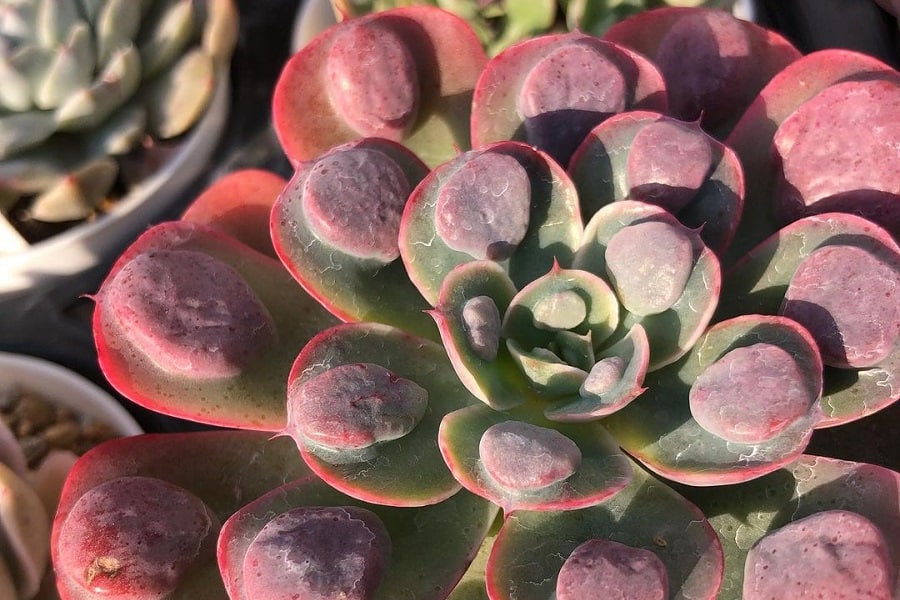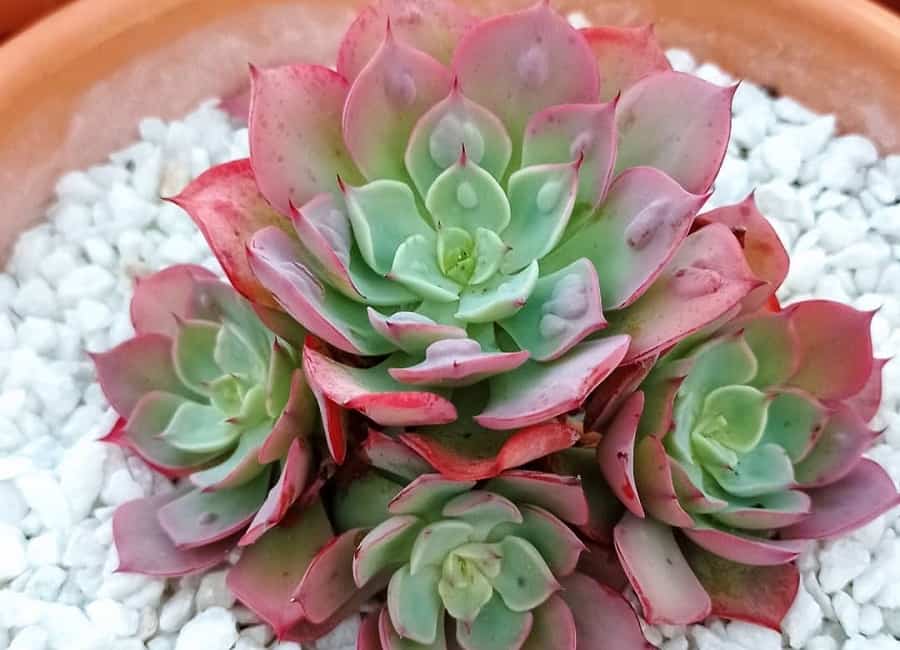Echeveria Raindrops: The Succulent Sensation You Need Now!
Succulents are taking the plant world by storm, and there’s one variety that’s causing quite a stir – the Echeveria Raindrops. With its jaw-dropping appearance and easy care, this little plant is about to become your new obsession. Get ready to fall head over heels for this succulent sensation!

Contents
About Echeveria Raindrops
Picture this: a compact rosette of fleshy leaves, each adorned with tiny, glistening bumps that resemble drops of rain. That’s the Echeveria Raindrops in all its glory! Measuring around 6 inches across, this petite succulent is a hybrid masterpiece created by the one and only Dick Wright.
Don’t let its small size fool you – the Raindrops succulent packs a punch with its eye-catching green leaves tinged with a reddish hue along the edges. But wait, there’s more! Those blue-green bumps on the surface give the illusion of sparkling raindrops, adding an extra touch of magic to this already enchanting plant.
Related Post:
160+ Amazing Echeveria Types with Pictures
Echeveria Raindrops Care Guide
Light
Like most succulents, the Echeveria Raindrops craves lots of bright, direct sunlight. Aim for at least 4-5 hours of sunshine per day to keep it happy and thriving. During the summer months, feel free to take your little gem outside and let it bask in the glory of Mother Nature’s rays.
If you’re keeping it indoors, a sunny window or a grow light will do the trick. Grow lights are artificial light sources designed to mimic natural sunlight, and they’re a game-changer for indoor succulent enthusiasts. Position the grow light about 6-12 inches above your Raindrops succulent and leave it on for 12-16 hours per day to provide the perfect amount of light.
Water
Like most succulents, Echeveria Raindrops is drought-tolerant and prefers infrequent watering. Allow the soil to fully dry out between waterings, then give it a good soak until water drains from the bottom of the pot. During the winter months, cut back on watering even further. As a rule of thumb, it’s better to underwater than overwater this plant.
Soil
Echeveria Raindrops needs a well-draining soil mix to prevent issues like root rot. A cactus or succulent potting mix from your local nursery is perfect. If making your own, use a gritty mix of two parts potting soil, two parts coarse sand or perlite, and one part crushed granite or pumice. Good drainage is key!

Fertilizer
Feed your Echeveria Raindrops sparingly with a balanced, diluted fertilizer every 2-3 weeks during the spring and summer growing season. Too much fertilizer can cause fertilizer burn. In the winter months, hold off on feeding.
Climate
This sun-lover thrives in warm temperatures between 65-80°F in the summer. Cooler temps down to 50°F are okay for winter. Avoid cold drafts and high humidity which can lead to rot. Echeveria Raindrops is happiest in dry, indoor conditions.
Potting and Repotting
Use a pot slightly larger than the rootball with drainage holes. Repot every 2-3 years in the spring into fresh succulent soil. Gently remove the root ball and replant at the same soil level in the new container.
Pruning
Pruning isn’t required, but can promote a neat, compact shape. Use clean shears to remove dead, damaged or leggy growth as needed. Prune off stretched, sparse growth to encourage fuller, compact form. Let cut ends dry before replanting pruned pieces to propagate new plants if desired. Regular light pruning helps maintain an attractive appearance.
Echeveria Raindrops Propagation Guide
One of the best things about the Echeveria Raindrops is how easy it is to propagate and multiply your collection. You can create new plants from stem cuttings, leaf cuttings, rosettes, or even seeds! Here’s a step-by-step guide to get you started:

Stem Cuttings
- Carefully cut off a stem from the mother plant, making sure to include a few leaves.
- Allow the cutting to callus over for a few days by letting it dry out.
- Once calloused, plant the cutting in well-draining soil and water sparingly.
- In a few weeks, you’ll see new growth and roots forming!
Leaf Cuttings
- Gently twist off a few healthy leaves from the mother plant.
- Allow the leaves to callus over for a few days.
- Lay the calloused leaves on top of well-draining soil and mist occasionally.
- In a few weeks, you’ll see new baby plants sprouting from the leaves!
Rosettes
If your Echeveria Raindrops has already formed multiple rosettes, you can easily separate them and plant them individually.
Seeds
Propagating from seeds is a bit trickier, but it’s definitely doable. Simply collect the seeds, sow them in well-draining soil, and be patient – it may take several weeks for them to germinate.
